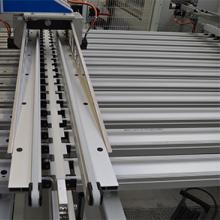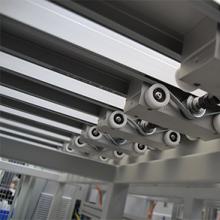

BRECO® Timing belts Help Control Costs
The price of solar panels has dropped over the past few years and even long-established companies face enormous cost pressure. Therefore, the international industry urgently needs new solutions to exceed the previous limits in solar panel production. The relatively young company, Somont from Umkirch, is committed to creating innovative solutions and has developed a new method for transporting solar strings that achieves 20 percent higher throughput.
Somont GmbH, located in Umkirch near Freiburg and a member of the Meyer Burger Group, has around 70 employees and develops a range of machines such as stringers (soldering machines for solar cells), handling machines and testing systems. Somont supplies machines to solar panel manufacturers. The machines are produced in Thun in Switzerland and in Hohenstein in Saxony. The Meyer Burger Group, with its various subsidiaries, covers all aspects of the value-added chain in photovoltaic production.

From the silicon block to the solar module
Producing a solar module from a silicon block is an extremely complicated process, involving many steps. The manufacturing process can be roughly divided into three main production steps: Wafer, cell and module. In the first step, the silicon block is cut by diamond-coated wires into slices measuring only a few tenths of a millimetre in thickness. From these slices raw wafers with an edge length of 6 inches are produced, and then, in a wet chemical process, the cell itself. In a screen-printing process, a fine structure made of metal paste is printed onto the silicon cell so that it is possible to access the electric current. Part of this structure forms the busbars, to which solder-coated copper tabbing ribbons are soldered. The tabbing ribbons conduct the electric power generated in the cell within the string – this is the name for the row of soldered cells. A string typically consists of five to twelve cells, and the soldering machines are referred to as stringers.
A special film is placed onto a glass plate that later protects the cells from the weather. Six to eight cell strings, the string matrix, are applied side-by-side to this film. Then additional films are applied. When the parallel cell strings have been interconnected at the edges, they are encapsulated: The films are melted with the aid of vacuum and heat so that the cell strings are completely encapsulated in plastic. Typical modules currently have 60 or 72 cells and achieve an output of 260 to 300 watts.

Selling points – throughput and breakage rate
Customers and operators assess the productivity of a machine line according to the breakage rate and the number of cells produced per hour. “These are the most important parameters. Breakages can easily occur in automated processes if the cells and strings are not correctly handled,” Bernd Hirzler, Chief Designer at Somont, explains. “When we developed the first stringers, the state-of-the-art throughput was 600 to 700 cells per hour. About four years ago we achieved a throughput of 1200 to 1300 cells per hour – this has now been increased to 2000 cells per hour. We use two stringers in parallel in our lines, achieving a throughput of 4000 cells per hour,” says the Somont engineer. As a result, the handling machines that take the strings and transport them to the glass plate are now reaching their technical limits. Large gantry axis systems with a length of up to 10 m are normally used for this. The current gantry system achieves a throughput of 2800 cells per hour. The gantry axis systems are of a very heavy design although the strings only weigh a few hundred grams.
Bernd Hirzler explains: “The axis systems have to be extremely rigid to ensure precision and repeatable accuracy of positioning, and to prevent damage to the cells from vibrations during the movements.” Transport via gantry axis systems has two limitations: on the one hand, the mechanical stress of dynamically lifting the strings using suction cups, and on the other hand, the empty and unproductive return of one of the gantries for the next string. Somont was looking for a new solution to solve these two core problems.

Innovative string transfer station
From the beginning, the objective of the new transfer station was to ensure very gentle and jolt-free transport of the strings and to find an alternative to the heavy Cartesian gantry axes. Suction grippers were to be avoided if possible, too. “The timing belt transport system is a completely new approach to solar module production. We no longer use axes and grippers but a large number of parallel belts for transporting the strings. The strings simply lie on the timing belts,” Sebastian Schittkowitz, Project Manager at Somont, explains.
This system functions as follows: When the string is located in the end position on the two-part crossbeam, a lifting device moves up and lifts the strings gently out. Then the two arms of the beam move apart to open the beam to the side. The lifting device moves the string down and transfers it to the conveyor belts. Finally the arms of the beam move together for the next string. Each cell lies on two timing belts.
Costs halved with module and parts commonality concept
For a string of ten cells, a total of 20 timing belts and another 2 timing belts for the cross beam and lifting device are required. This can easily result in 100 timing belts for a complete transfer system. “During the design phase, we discussed making the transport system as simple as possible in order to control the costs,” says René Preßler from Hilger u. Kern.
This led to a modular design with the use of common parts. “All the belts used are standard open length belts. The small 3 mm pitch of the BRECO® timing belt permits a flexible belt and thus small low-cost belt pulleys and bearing blocks,” says René Preßler. Individual belt axes can be held in stock by the customer as ready pre-assembled units, allowing easy replacement when required. It is only necessary to undo a few screws and the couplings of the drive shaft for this.
The largest saving was realised by doing without tensioning devices for the belt drives and matching the tolerances of belts, pulleys, bearing blocks and profiles accordingly. For this, Hilger u. Kern, in consultation with the manufacturer and Mulco partner, BRECO Antriebstechnik, reduced the length tolerance of the AT3 PU timing belt. In comparison to the former multi-axis system, this handling system seems very refined. It is no longer necessary to move large masses and drives in order to achieve precision and productivity. With this transfer system, it doesn’t matter if a string of five or ten cells is being produced. “As the old system used suction cups, it was necessary to always produce the same number of strings on a machine. With the new timing belt transfer system, we have considerably improved flexibility, quality and productivity of the production line for our customer,” Bernd Hirzler concludes.
